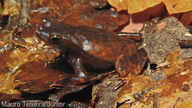|
Description
Males 46-54 mm, females 46-55 mm. The skin is smooth in males and granular in females. The dorsal surface usually has irregular brown and black patches, but some individuals are almost uniform reddish or dark brown. There may be a light mid-dorsal line. The head is triangular, and the snout pointed. A line of tubercles extends from behind the eye along the side to the base of the legs. The belly is gray to brown.
Juveniles are similar to Dendrophryniscus minutus in general form, but the ventral surface of D. minutus is black at the front, and spotted black and white on the hind part. Distribution and Habitat
Country distribution from AmphibiaWeb's database: Brazil, Colombia, Ecuador, Peru
Distribution through the Amazonian River system, from Manaus, Brazil, west through to presumably Peru, Colombia, and Ecuador. Occurs throughout the Reserva Florestal Adolpho Ducke in Brazil.Life History, Abundance, Activity, and Special Behaviors
The species is terrestrial and diurnal. In the Reserva Florestal Adolpho Ducke, the diet consists mainly of mites, ants, spiders, beetles and crickets. Reproduction occurs mainly between March and May. Breeding groups form for 2-3 days in pools or seeps near the headwaters of streams. Males call during the day and night, and more than 100 females can be found in one day at a single breeding site. Breeding groups form at different sites throughout the season, but it is not known whether individuals breed at different sites during a single breeding season. Clutches contain about 450 eggs. Comments
Taxonomic Note (David Cannatella):
The taxonomic history of toads with the species name "proboscidea" is confusing. This species, restricted to the Amazon basin, was named by Spix in 1824, and has been variously placed in Bufo, Oxyrhynchus, Eurhina, and most recently, Rhinella. Unfortunately, there is another proboscidea species, named by Boulenger in 1882 for a species in southeastern Brazil. This latter species was explicitly moved to Rhinella by Chaparro et al. (2007; Copeia, 2007:1027) and so became Rhinella proboscidea. However, this action created a conflict, because there already existed an older Rhinella proboscidea, the Amazonian described in this account, named by Spix. The rules of nomenclature do not permit the use of two different "Rhinella proboscidea," a conflict known as homonymy--the same name for different species.
To resolve this, the older name is preferred--Rhinella proboscidea of Spix, 1824, not of Boulenger, 1882. What this means is that the SE Brazilian species proboscidea of Boulenger needed to be given a new name. The replacement name chosen by Chaparro et al. (2007) was boulengeri, so the new genus-species combination was changed to Rhinella boulengeri. This action resolved the problem of having two Rhinella proboscidea.
Not long after, Fouquet et al. (2012, Zootaxa 3244:68) published a comprehensive analysis showing that Rhinella boulengeri should clearly be included within Dendrophryniscus. Since moving the species boulengeri from Rhinella to Dendrophryniscus resolves the problem of having two Rhinella proboscidea, the newly named species boulengeri reverts back to its original name proboscidea. That SE Brazilian species is now called Dendrophryniscus proboscideus.
However, the Amazonian species, for which this account was written, keeps the name Rhinella proboscidea.
Originally submitted by: Albertina P. Lima, William E. Magnusson, Marcelo Menin, Luciana K. Erdtmann, Domingos J. Rodrigues, Claudia Keller, Walter Hödl (first posted 2013-05-14)
Edited by: Michelle S. Koo (2021-07-23)Species Account Citation: AmphibiaWeb 2021 Rhinella proboscidea <https://amphibiaweb.org/species/8007> University of California, Berkeley, CA, USA. Accessed Nov 23, 2024.
Feedback or comments about this page.
Citation: AmphibiaWeb. 2024. <https://amphibiaweb.org> University of California, Berkeley, CA, USA. Accessed 23 Nov 2024.
AmphibiaWeb's policy on data use.
|




 Map of Life
Map of Life